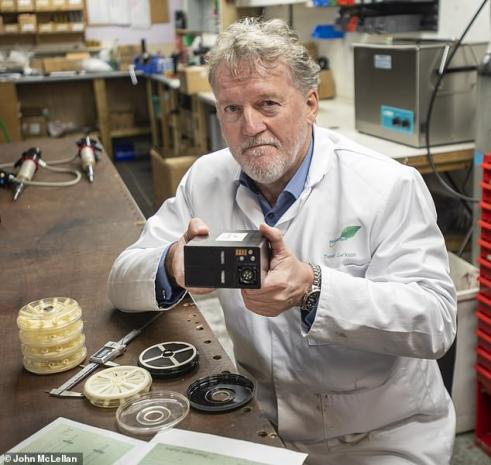
Breaking News
 Pentagon Creating National Guard 'Quick Reaction Forces' Across US: Reports
Pentagon Creating National Guard 'Quick Reaction Forces' Across US: Reports
 Tulsi Gabbard confirms official probe into Anthony Fauci for perjury...
Tulsi Gabbard confirms official probe into Anthony Fauci for perjury...
 Sen John Kennedy exposes the US Department of Interior under Biden created a DEI program for owls
Sen John Kennedy exposes the US Department of Interior under Biden created a DEI program for owls
 Grassley Investigates Gates, Rockefeller, and Ford Foundations Over Alleged CCP Funding
Grassley Investigates Gates, Rockefeller, and Ford Foundations Over Alleged CCP Funding
Top Tech News
 Graphene Dream Becomes a Reality as Miracle Material Enters Production for Better Chips, Batteries
Graphene Dream Becomes a Reality as Miracle Material Enters Production for Better Chips, Batteries
 Virtual Fencing May Allow Thousands More Cattle to Be Ranched on Land Rather Than in Barns
Virtual Fencing May Allow Thousands More Cattle to Be Ranched on Land Rather Than in Barns
 Prominent Personalities Sign Letter Seeking Ban On 'Development Of Superintelligence'
Prominent Personalities Sign Letter Seeking Ban On 'Development Of Superintelligence'
 Why 'Mirror Life' Is Causing Some Genetic Scientists To Freak Out
Why 'Mirror Life' Is Causing Some Genetic Scientists To Freak Out
 Retina e-paper promises screens 'visually indistinguishable from reality'
Retina e-paper promises screens 'visually indistinguishable from reality'
 Scientists baffled as interstellar visitor appears to reverse thrust before vanishing behind the sun
Scientists baffled as interstellar visitor appears to reverse thrust before vanishing behind the sun
 Future of Satellite of Direct to Cellphone
Future of Satellite of Direct to Cellphone
 Amazon goes nuclear with new modular reactor plant
Amazon goes nuclear with new modular reactor plant
 China Is Making 800-Mile EV Batteries. Here's Why America Can't Have Them
China Is Making 800-Mile EV Batteries. Here's Why America Can't Have Them
UK Man Invents Aluminum Air Battery In His Garage

Now imagine that power source uses recycled aluminum, one of the most abundant metals on Earth, and an electrolyte so non-toxic you can drink it.
Image credit: Chemicum/YouTube
Call this power source a battery. Call it a fuel cell. Call it whatever you like. It is an invention that could upend energy storage as we know it and drive the electrification of transportation — from bicycles and neighborhood electric vehicles to heavy trucks, airplanes, and cargo ships — forward at warp speed.
The person behind all this is UK engineer and former Royal Navy officer Trevor Jackson, who began experimenting with aluminum air batteries at his workshop in the Cornish town of Callington in 2001. At that time, the electrolyte used was extremely caustic and poisonous. After years of experimentation, Jackson devised a new electrolyte — whose composition is a closely guarded secret — he says make it possible for his invention to power an electric car for up to 1,500 miles.
What happens when it runs out of juice? You replace it with a new one while the old one gets recycled. At the beginning of the electric car era when charging infrastructure was nonexistent, the idea of swapping spent batteries for fully charged new ones was considered feasible. Jackson says such a thing could be the future, with his batteries/fuel cells sold at grocery stores and retail outlets. He says the process of disconnecting the old one and connecting the new one will take about 90 seconds.
But is it tin foil hat time? Is this story just another example of some crackpot inventing some radical new product that defies conventional physics, like cold fusion? Lots of people think so, and in fact Jackson says powerful forces have attempted to prevent his idea from reaching a larger audience. But an independent evaluation by the UK Trade and Investment agency in 2017 said Jackson's invention was a "very attractive battery" based on "well established'" technology, and that it produced much more energy per kilogram than standard electric vehicle types, according to a report in the Daily Mail.
Some comparisons are in order. A Tesla Model S can drive up to 370 miles on a single charge. Jackson says if you drove the same car with an aluminum-air cell that weighed the same as the Tesla's lithium-ion battery, it would have a range of 2,700 miles. Aluminum-air cells also take up less space. If that same Tesla were fitted with an aluminum-air fuel cell the same size as its current battery, it could run non-stop for 1,500 miles.
Jackson says the battery for that long range Tesla Model S costs about £30,000. Tesla aficionados will probably quibble with that number but Jackson claims his aluminum-air battery/fuel cell that could power the same car for longer would cost just £5,000. Of course, it the owner has to spend £5,000 every 1500 miles, the economic case for the new energy source is compromised somewhat. Time will tell.
Multi-Million Dollar Deal Is Signed
Think this is all crazy talk? Consider this. Jackson has just signed a multi-million dollar deal with Austin Electric, an engineering firm based in Essex which now owns the rights to use the old Austin Motor Company logo. It will begin putting thousands of them into electric vehicles next year. According to Austin's chief executive, Danny Corcoran, the new technology is a "game-changer. It can help trigger the next industrial revolution. The advantages over traditional electric vehicle batteries are enormous."

 China Innovates: Transforming Sand into Paper
China Innovates: Transforming Sand into Paper


